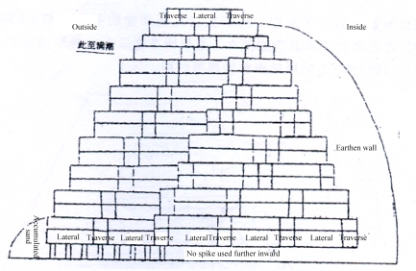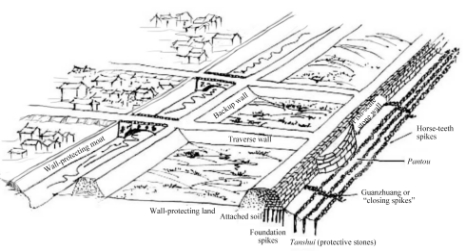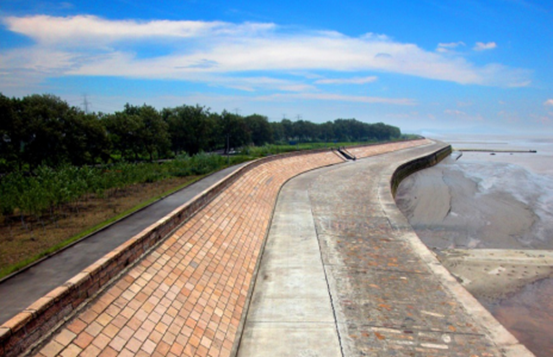
Fig.1 Evolution of the Shoreline at the Qiantang River Estuary and the Location of the “Three Gates” [San men] (from Haining City Administration of Cultural Heritage)
The Qiantang River, the largest river in China’s Zhejiang Province, is named after the ancient county of Qiantang (today’s city of Hangzhou). With a catchment area of 55058 Km2, the Qiantang River runs for 588.73 kilometers from its northern source to its estuary at the Xin'an River. It flows through Anhui and Zhejiang provinces, and finally empties into the East China Sea at Hangzhou Bay.
The Seawalls of the Qiantang River are dykes built on both sides of the Qiantang Estuary to resist strong tidal erosion. As one of the natural wonders of the world, the river tide of the Qiantang River is known as "the champion tide on earth". It is formed by tidal currents entering the estuary under the centrifugal effect of gravity and the rotation of the Earth, in addition to the special topographical features of the estuary. On the occasion of the astronomical tides, the tidal bore can reach as high as nearly 10 meters, which would destroy nearby homes and farmland if no seawalls had been constructed. Seawalls were built and reinforced during each and every dynasty in order to withstand the intrusion of salt tides.
The Seawalls of the Qiantang River, which are mostly earthworks, were first built in the Eastern Han Dynasty (25 to 220 AD) and gradually expanded along both banks of the river. Stone seawalls appeared during the Tang Dynasty (618 to 907 AD), . In the fourth year of the reign of Emperor Kaiping (910 AD) during the Liang Dynasty (907 to 923 AD), Qian Liu, ruler of the small kingdom of Wuyue,, invented “Bamboo Cage Stone Wall” (see Fig.2). During the Northern Song Dynasty (960 to 1127 AD), firewood, willow, vertical stone and slope stone walls were subsequently adopted. Five vertical and five horizontal fish-scale stone walls prevailed during the Ming Dynasty (1368 to 1644 AD). In the Qing Dynasty (1616-1912 AD), the local government developed a tidal wave defense-in-depth system (see Fig.4) consisting of a foundation project, main wall, backup wall, traverse wall, backup wall river and wall protection works.

Fig.2 “Bamboo cage stone wall” invented by Qian Liu, King of Wuyue

Fig.3 Five vertical and five horizontal fish-scale stone wall designed by Huang Guangsheng in the Ming Dynasty

Fig.4 The Ming Dynasty defense-in-depth system against tides of the Qiantang River
After the establishment of General Administration for Seawalls of Zhejiang in the 34th year of Emperor Guangxu’s reign (1908) in the Qing Dynasty, new foreign technologies were introduced for the construction of concrete gravity walls (see Fig.5) in Haining County from 1919 to 1927. After the founding of the People's Republic of China, the seawalls were completely renovated, thanks to the repairing and strengthening of old, scattered and branch dykes. The construction of standardized walls began at the end of the 20th century (see Fig.6 and Fig.7).
The maintenance of the Qiantang Seawalls has always been a governmental priority throughout the history of China. Since the Tang Dynasty, the management of seawalls has been recorded. Regular repair and maintenance was carried out by the county government from the Song Dynasty (960 to 1279 AD) to the Ming Dynasty. The seawalls were coded section by section in Haiyan County during the Ming Dynasty, each section measuring 20 zhang (the equivalent of 3.33 meters), in order to clarify the specific location of each section and exercise section-based management. A dedicated commissioner was appointed by the central government to manage the seawalls during the Qing Dynasty. After the founding of the People's Republic of China, the Qiantang River Authority was established. In order to ensure unified management of the seawalls, mileage pegs were used to replace the thousand-character monuments.

Fig.5 Cement wall built in Haining City, Zhejiang Province, in 1919

Fig.6 Modern standardized slope-type walls in Hangzhou City,
Zhejiang Province

Fig.7 Modern standardized vertical walls in Hangzhou City,
Zhejiang Province